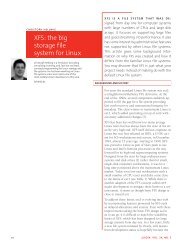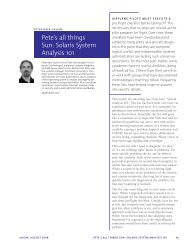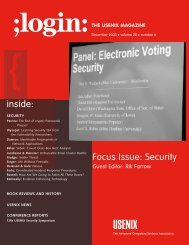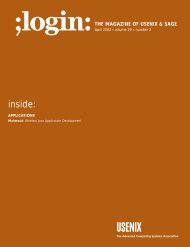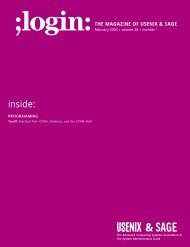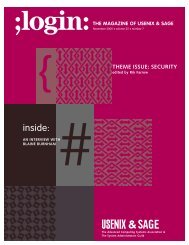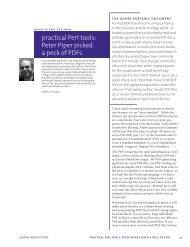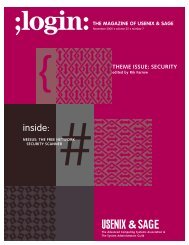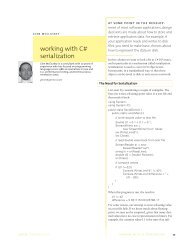You also want an ePaper? Increase the reach of your titles
YUMPU automatically turns print PDFs into web optimized ePapers that Google loves.
Outlook 2000 and XP that will watch the<br />
way users categorize messages into folders,<br />
come up with a profile for what<br />
kinds of messages end up in which folders,<br />
and then try to offer similar categorization<br />
on an automatic basis. Think of<br />
it as procmail for Outlook, without having<br />
to mess with (or even be aware of!)<br />
all the nasty recipes.<br />
Obviously, if you have a spam folder,<br />
then spam will be one of the categories<br />
it looks for, but, more broadly, it will try<br />
to categorize all your mail as you would<br />
ordinarily categorize it. This makes<br />
SmartLook a broader tool than “just” a<br />
spam manager.<br />
SmartLook is another statistical filter,<br />
though it uses non-Bayesian algorithms<br />
to get results. e-labs’ tests suggest that<br />
the product is able to properly categorize<br />
messages about 96% of the time,<br />
with no false positives, and (for their<br />
tests, mind you) that it performed better<br />
than Bayesian filters over three months<br />
of usage.<br />
One nice property of this tool was that it<br />
works well with different (human) languages<br />
– some strategies fall apart<br />
and/or need retraining when you switch<br />
from English to some other language.<br />
For certain markets (e-lab is in France)<br />
this is a crucial feature, and having a tool<br />
that works with one of the biggest mail<br />
clients out there (most people don’t use<br />
Mutt or Pine, sadly enough) can be very<br />
valuable. Very clever – watch for the<br />
inevitable embrace and extend three<br />
years from now.<br />
LESSONS FROM BOGOFILTER<br />
Eric Raymond, Open Source Initiative<br />
He didn’t say anything about guns, but<br />
he did try to correct one of the other<br />
speakers for misusing the term “hacker.”<br />
Like Graham, ESR is a Lisp fan, but he<br />
knows that the vast majority of people<br />
aren’t, and he also knows that the vast<br />
majority of people need to be using<br />
something like Graham’s spam software.<br />
So on a lark, he came up with a clean<br />
version in C, named it bogofilter, and<br />
put it on SourceForge, where a community<br />
sprang up to, well, embrace and<br />
extend it.<br />
As good as Graham’s Bayesian algorithm<br />
is, ESR felt – as did many of the other<br />
speakers – that the nature of your<br />
spam/ham corpus is much more significant<br />
than the relative difference among<br />
any handful of reasonably good algorithms.<br />
(Back to the often-repeated<br />
point about how corpus effectiveness<br />
falls apart when used for a group of<br />
users, as opposed to individuals.)<br />
To that end, he strongly felt that the best<br />
way to deal with the spam problem is to<br />
get good tools into the hands of as many<br />
people as possible, and to make them as<br />
easy to use as possible.<br />
As an example, one of the first things he<br />
did was to patch the Mutt mail agent so<br />
that it had two delete keys: one for general<br />
deletion and one to “get rid of this<br />
because it’s spam.” That second key, and<br />
interface touches like it, seem like the<br />
way to get average people to start using<br />
filters on a regular basis.<br />
SPAM FILTERING: FROM THE LAB TO THE<br />
REAL WORLD<br />
Joshua Goodman, Microsoft Research<br />
Unlike ESR, Goodman felt that algorithm<br />
selection does make a big difference,<br />
but, this being Microsoft, he<br />
refused to disclose what algorithms his<br />
team is working with – except to say<br />
that, when delivered, they will be more<br />
accessible for average users than<br />
<strong>Spam</strong>Assassin, procmail recipes, or<br />
Mutt.<br />
Microsoft has been working on the spam<br />
problem since 1997, but because of how<br />
big they are, they’ve had unique problems<br />
in bringing solutions to market. As<br />
a case in point, they tried to introduce<br />
spam filters in a 1999 Outlook Express<br />
release, but were immediately sued by<br />
email greeting card company Blue<br />
Mountain because their messages were<br />
being inaccurately categorized as spam.<br />
With that in mind, they have been very<br />
reluctant to bring new anti-spam software<br />
out since then, because they would<br />
like to see legislation protecting “good<br />
faith spam prevention efforts.”<br />
As a very large player, Microsoft faced<br />
certain difficulties in developing useful<br />
filters: It may make sense for you as an<br />
individual to filter all mail from Korea,<br />
but this doesn’t work so well if you are<br />
trying to attract customers from Korea.<br />
This has forced them to put a lot of<br />
work into thoroughly testing different<br />
strategies before offering them to the<br />
public.<br />
In spite of what millions of Webmail<br />
users might have expected, Hotmail and<br />
MSN are currently being filtered by<br />
Brightmail’s service, and plans are<br />
underway to re-introduce spam-management<br />
features to client-side software<br />
again. (Just imagine how bad it would<br />
be if they weren’t paying someone to filter<br />
for them!)<br />
An interesting barrier his group has had<br />
to grapple with was what he called the<br />
“Chinese menu” or “madlibs” spam generation<br />
strategy: that it’s easy to come up<br />
with a template for spam – “[a very special<br />
offer] [to make your penis bigger]<br />
[and please your special lady friend all<br />
night!” vs. “[an exclusive deal] [for genital<br />
enlargement] [that will boost your<br />
sex life!]” etc. – and have a small handful<br />
of options for each “bucket” multiplying<br />
into a huge variety of individual messages<br />
that are easy for a human to group<br />
together but almost impossible for software<br />
to identify.<br />
INTEGRATING HEURISTICS WITH N-GRAMS<br />
USING BAYES AND LMMSE<br />
Michael Salib, extremely funny <strong>MIT</strong><br />
student<br />
Unlike nearly all other filter writers of<br />
the day, Salib’s approach was heuristic:<br />
find a handful of reasonable spam discriminators,<br />
throw them all against his<br />
mail, and see how much he can identify<br />
that way. “It’s sketchy, but this is a class<br />
● CONFERENCE REPORTS<br />
June <strong>2003</strong> ;login:<br />
<strong>MIT</strong> SPAM CONFERENCE ●<br />
67



